Hi Folks - I'm a newbie here, usually on Alaska Gold Forum but lived in Mongolia since 1995. Then there was just one working dredge in Mongolia, and only a few dry mines. I've been documenting the placer gold rush since, now with 135 placer mining companies working 200 placer mines, and the Mongolian Dredge Fleet now has SIX large bucket line gold dredges and about 20 smaller bucket line dredges. I'm posting to share knowhow and ideas. And I am hoping someone will volunteer pics of the Snowstorm Dredge (especially its riffles) for me to include in the Tech Manual I've nearly completed for publication.
First I'll try and post some pics of the gold dredges to see if you folks are interested. If you want to visit them it can be arranged!
We'll see how it goes - I would like to discuss PLACER DRILLING later on, as there is a systemic error that means understimation of gold reserves beneath wet floodplains. This error seems to be ignored in the USA and Canada, but please realise that the 6 giant Gold Dredges in Mongolia exist ONLY because the systemic error was corrected by the soviets just before the command economy collapsed.
Enjoy the pics and realise that - if I'm right - then large gold dredges would be profitable in USA and Canada on placers formerly written off as subeconomic grades.
cheers - Steppe
Full Version: Giant GOLD DREDGES make a comeback
Colorado Prospector - Gem and mineral prospecting and mining forums > Prospecting, Mineral Collecting and Treasure Hunting Forums > Historical Equipment and Tales
This is not an old picture in the USA it is of one of the 6 giant gold dredges in Mongolia.
Its what we call the 'North Dredge' of Shijir Alt company, strictly speaking its Shijir Alt #1.
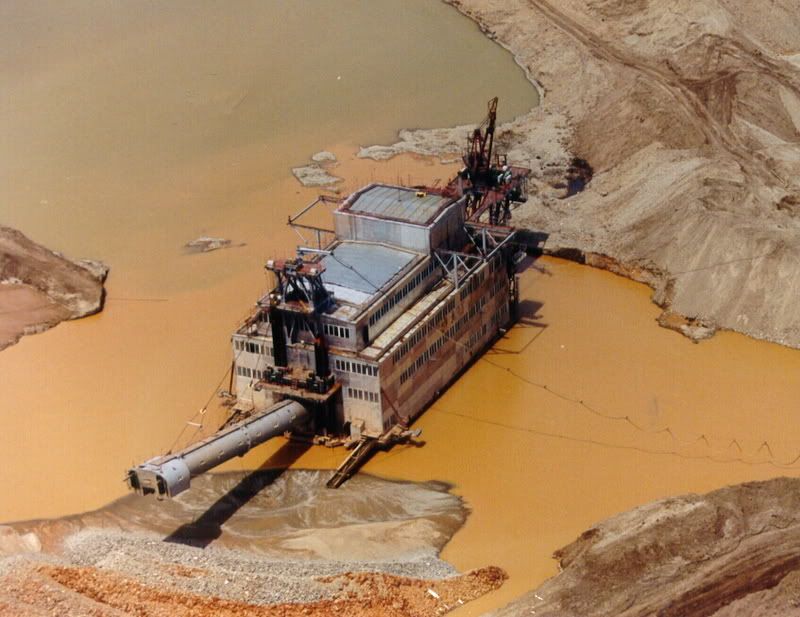
Thanks to Golden Tiger Corporation for the picture.
Its a bucket-line dredge built in Irkutz in Siberia by IZTM who built all 6 of the Mongolian Dredge Fleet and also built the entire Russian Dredge Fleet and they include not only gold dredges but also a few platinum and diamond dredges.
Its what we call the 'North Dredge' of Shijir Alt company, strictly speaking its Shijir Alt #1.

Thanks to Golden Tiger Corporation for the picture.
Its a bucket-line dredge built in Irkutz in Siberia by IZTM who built all 6 of the Mongolian Dredge Fleet and also built the entire Russian Dredge Fleet and they include not only gold dredges but also a few platinum and diamond dredges.
The Mongolian Dredge Fleet operates for most, but not all, of the winter. Its minus 30-40 centrigrade in a normal winter! Here you can see smoke from tehe coal-fired bunker that via a boiler and pipes keeps the washplant working.
Its the North Dredge again, thanks to Gerrit-the-Dredge for the pic.
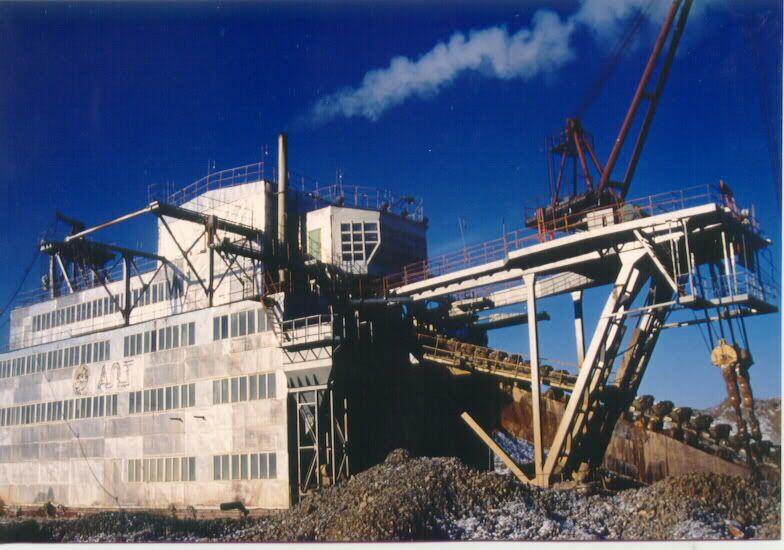
Its the North Dredge again, thanks to Gerrit-the-Dredge for the pic.

It sure is a BUCKET-LINE dredge, and here is the bucket-line raised clear of the water "just for the photo"!


I'll try to post some more later - any comments so far?
I have a question.
How many dredges were active in Colorado, how many are preserved and are there any plans for new dredge projects?
Thanks

Steppe
I have a question.
How many dredges were active in Colorado, how many are preserved and are there any plans for new dredge projects?
Thanks
Steppe
GREAT Pics Step 
the wacoenviros would go nuts if bucketline dredges were brought back into production in the good ole USA!
Welcome to the forums Steppegold and thanks for the fantastic pictures.
I also have a great interest in the old bucket-line dredges.
Here is a link to pictures Dan Martin took and gave us permission to use on the CP site. You will love them!!

Snowstorm Dredge thread
more Snowstorm Dredge pictures
Im moving this thread to the "Historical Equipment/Tales" forums.
I also have a great interest in the old bucket-line dredges.
Here is a link to pictures Dan Martin took and gave us permission to use on the CP site. You will love them!!
Snowstorm Dredge thread
more Snowstorm Dredge pictures
Im moving this thread to the "Historical Equipment/Tales" forums.
That is some great pictures of a monster dredge. I wish they would allow them again here in the USA. I have had the opportunity to visit a dredge in Virginia City Montana and near Salmon Idaho that are similar in size to the one in Colorado but nothing near the size of that one. Keep the pictures and information coming 
Hi, time to look at a second member of the Mongolian Gold Dredge Fleet.
This one is further down the Tuul Valley and is known as the Bayangol Dredge. It was first owned by Hailaast JSC but this State owned enterprise could not pay for it fully so it was privatized and a Russian company Altan Dornod Mongol (Golden East - Mongolia) now own and operate it.

Notice that the entire dredge is winterized by cladding, and the rear stacker conveyor can be lowered onto the ground when the dredge is resting. Notice the dozer for scale!
cheers - Steppe
This one is further down the Tuul Valley and is known as the Bayangol Dredge. It was first owned by Hailaast JSC but this State owned enterprise could not pay for it fully so it was privatized and a Russian company Altan Dornod Mongol (Golden East - Mongolia) now own and operate it.

Notice that the entire dredge is winterized by cladding, and the rear stacker conveyor can be lowered onto the ground when the dredge is resting. Notice the dozer for scale!
cheers - Steppe
The Bayangol Gold Dredge is mining close to a fault scarp created in the post Neogene - that means quite recently. Between the dredge and the mountain is the Tuul River (out of sight).

Over the years we've coined the term 'crocodile' for the ribbon of coarse oversize tailings dumped by the rear stacker, the crocodile being made of bananas!

Over the years we've coined the term 'crocodile' for the ribbon of coarse oversize tailings dumped by the rear stacker, the crocodile being made of bananas!
A banana is made when the bucket-line dredge makes a swing. You may not of seen (or heard!) the swing of a bucket-line dredge, so specially for you here is the South Dredge of Shijir Alt:
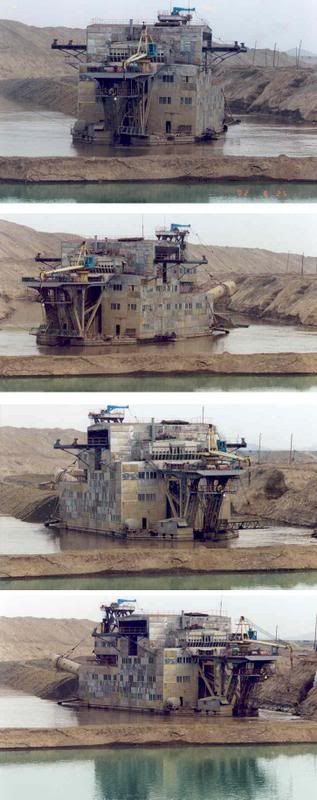
The dredgemasters say the noise of a dredge is when a dredge sings...

The dredgemasters say the noise of a dredge is when a dredge sings...
Here is the result of the South Dredge swinging on its spuds and singing... ....a crocodile made of bananas!


And I'd better show you some buckets on a line to show these really are bucket-line dredges and so do their own digging and feeding unlike the dragline-fed Snowstorm Dredge (as I understand it?).
Here are the buckets of the Bayangol Dredge.

Here are the buckets of the Bayangol Dredge.

Its quite a remote place where the dredges are, and here is some of the wildlife.

Thanks to Chimee for the pic

Thanks to Chimee for the pic
Moving a little downvalley, here is the first of the pair of Toson Dredges - both owed by a Mongolian woman miner Garamjav.
This is the South Toson Dredge. It is slighty squatter than the sister dredges in order to enable it to twist and turn in the narrow floodplain it was designed for in Tolgoit in North Mongolia. When it had exhausted its reserves, Garamjav bought the dredge had it cut up into about 200 truckloads and had it reassembled here in the Tuul Valley.
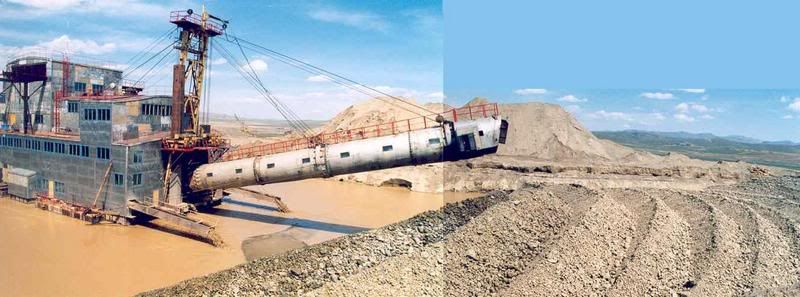
You can see big bananas being formed by washed oversize dumped by the winterised rear stacker conveyor, and notice the 2 spuds - one up, one down - the down spud acts an anchor on which the dredge swings. Forward movement is by twisting the dredge and dropping the second spud and raising the first spud, rather like walking on stilts.
The 2 discharge chutes are discharging water and undersize tailings from the washplany aboard the dredge. The fine tailings (with fine gold the sluices cannot catch, plus coarse gold stolen by sticky clay robbers) are dumped first and then buried by the oversize bananas (with nuggets and improperly washed clay balls with gold) of the crocodile.
These dredges are designed to use mercury but do not do so - mercury usage at placer gold mines was BANNED in the Soviet Union and in Mongolia in order to protect the health of mineworkers. The design of the dredge remains the same.
This is the South Toson Dredge. It is slighty squatter than the sister dredges in order to enable it to twist and turn in the narrow floodplain it was designed for in Tolgoit in North Mongolia. When it had exhausted its reserves, Garamjav bought the dredge had it cut up into about 200 truckloads and had it reassembled here in the Tuul Valley.

You can see big bananas being formed by washed oversize dumped by the winterised rear stacker conveyor, and notice the 2 spuds - one up, one down - the down spud acts an anchor on which the dredge swings. Forward movement is by twisting the dredge and dropping the second spud and raising the first spud, rather like walking on stilts.
The 2 discharge chutes are discharging water and undersize tailings from the washplany aboard the dredge. The fine tailings (with fine gold the sluices cannot catch, plus coarse gold stolen by sticky clay robbers) are dumped first and then buried by the oversize bananas (with nuggets and improperly washed clay balls with gold) of the crocodile.
These dredges are designed to use mercury but do not do so - mercury usage at placer gold mines was BANNED in the Soviet Union and in Mongolia in order to protect the health of mineworkers. The design of the dredge remains the same.
Here is the front end of the Toson Dredge. Being owned by a woman it is the neatest of the dredges!
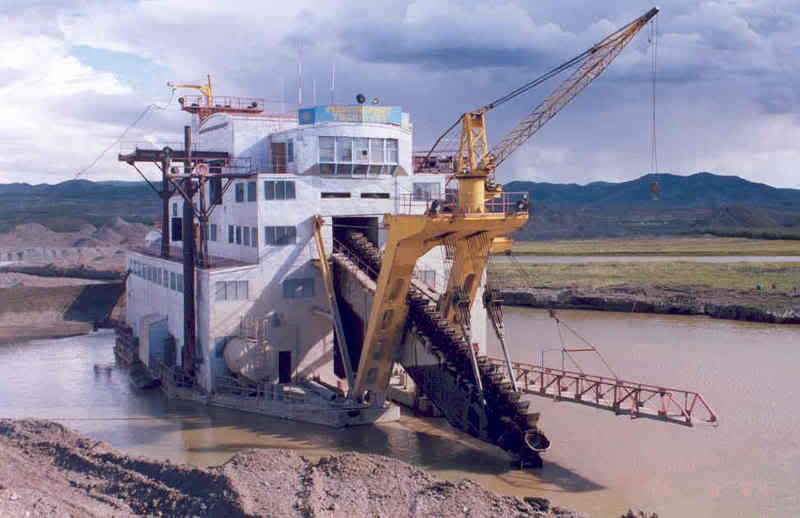

That's enough pictures for today - any comments or questions?

Steppe
Steppe
Cool very cool. Joe
thats a really neat picture tour you gave us! thankyou!
Fantastic pictures and info!! 
Correct, the Snowstorm Dredge was a drag-line dredge. There were 2 dredges that worked near Fairplay Colorado.
Here is a link to a picture of the BIG bucket-line dredge that worked here.
http://history.oldcolo.com/history/research/mining_5.html
If you look at the CP webcam, you can see a small piece of the tailings it left on the right.
Denise
Correct, the Snowstorm Dredge was a drag-line dredge. There were 2 dredges that worked near Fairplay Colorado.
Here is a link to a picture of the BIG bucket-line dredge that worked here.
http://history.oldcolo.com/history/research/mining_5.html
If you look at the CP webcam, you can see a small piece of the tailings it left on the right.
Denise
QUOTE (Steppegold @ Feb 15 2007, 05:21 PM)
That's enough pictures for today - any comments or questions?
Steppe
Steppe
Hi, Steppe,
I'm watching this thread with keen interest.
Will you please continue to post.
I'm especially intrigued by the offer you've made to discuss the qualitative error of drilling results when followed up by mining using bucketline dredges.
Hurry back.
Megan Rose
I/m more interested in the efficency of a bucketline compared to that of a suction dredge.
Gold_Tutor - sorry I've been late in replying.
We all trust the churn drill (=placer drill, cable tool drill, motorised banka drill).
So did I.
But not now.
The world's largest repeat drilling by churn drill and bucket drill is in a 50km stretch of the Tuul floodplain here in Mongolia, a formerly 'Top Secret' report by Soviet placer geologists. The answer is stunning. The churn drills lost so much gold compared with the bucket drills. Wow!
Churn drills are OKish on dry terraces and for shallow holes, as shown by the Yukon drilling tests using radiotracer gold.
Churn drills on floodplains or deep enough to be in wet ground UNDERestimate the gold content by 30-60%. That is amazing.
And the Soviet churn drills are as good as or better than your North American churn drills as the diameter is 325mm giving a much bigger sample and far less noise from sidewall effects.
I am preparing an article for publication on this and will report back when its ready.
cheers
Steppe
We all trust the churn drill (=placer drill, cable tool drill, motorised banka drill).
So did I.
But not now.
The world's largest repeat drilling by churn drill and bucket drill is in a 50km stretch of the Tuul floodplain here in Mongolia, a formerly 'Top Secret' report by Soviet placer geologists. The answer is stunning. The churn drills lost so much gold compared with the bucket drills. Wow!
Churn drills are OKish on dry terraces and for shallow holes, as shown by the Yukon drilling tests using radiotracer gold.
Churn drills on floodplains or deep enough to be in wet ground UNDERestimate the gold content by 30-60%. That is amazing.
And the Soviet churn drills are as good as or better than your North American churn drills as the diameter is 325mm giving a much bigger sample and far less noise from sidewall effects.
I am preparing an article for publication on this and will report back when its ready.
cheers
Steppe
Coalbunny - you asked a good question:
"I'm more interested in the efficency of a bucketline compared to that of a suction dredge."
Its actually a bit convoluted to give a proper answer.
A BIG bucket-line dredge should recover ALL the material provided it is small enough to fit in the bucket. My friends caught a Mammoth in one of the buckets of their bucket-line dredge.
A bucket-line dredge usually swings as it cuts, and therefore it is usual to have an onboard washplant. That's OK, but the nature of the swing and dredging limits the length of the dredge, so often the space for the onboard washplant is limited. That means a brilliant dredge is likely to have a not-as-good-as-it-should-be onboard washplant, and retrofitting a new washplant is impossible without stopping production for months.
Right, now for suction dredges.
An advantage of a BIG suction dredge is that it generates slurry that can be pumped to a floating washplant sat on a barge/pontoon nearby or even at a distance. Therefore there is no limit to the size or layout of the washplant, it can be altered easily, and retrofitting can be done without any serious delay.
The disadvantage of a suction dredge is that if the material is cobbly, as it often is, then the cobbles cannot be pumped up and so one by one accumulate on the bed of the dredge pond. That is not a good idea for eventually it means that the suction dredge cannot get at the virgin material below, or if it does then the gold is liable to be dropped in the crevices between the cobbles - the dredge pond may end up carpeted in gold! In contrast a heavyweight bucket line dredge is able to rip loose bedrock.
That said, cutter suction dredges are cheaper to buy than bucket line dredges, are much more readily available as they are civil engineering dredges for rivers and coastline, and are much easier and quicker to transport, assemble, disassemble and truck to the next location. It can be as quick as a few days, but for a bucket line dredge it is usually some months, often many months.
Cutter suction dredges are probably cheaper to operate and cheap enough to also remove the overburden. Indeed a winning combination in terms of cost, speed, recovery, freedom of movement and rehabilitation is a cutter suction dredge up front to pump away the overburden followed by a bucket-line dredge that mines (and washes) only the placer.
I hope this helps a bit
Steppe
"I'm more interested in the efficency of a bucketline compared to that of a suction dredge."
Its actually a bit convoluted to give a proper answer.
A BIG bucket-line dredge should recover ALL the material provided it is small enough to fit in the bucket. My friends caught a Mammoth in one of the buckets of their bucket-line dredge.
A bucket-line dredge usually swings as it cuts, and therefore it is usual to have an onboard washplant. That's OK, but the nature of the swing and dredging limits the length of the dredge, so often the space for the onboard washplant is limited. That means a brilliant dredge is likely to have a not-as-good-as-it-should-be onboard washplant, and retrofitting a new washplant is impossible without stopping production for months.
Right, now for suction dredges.
An advantage of a BIG suction dredge is that it generates slurry that can be pumped to a floating washplant sat on a barge/pontoon nearby or even at a distance. Therefore there is no limit to the size or layout of the washplant, it can be altered easily, and retrofitting can be done without any serious delay.
The disadvantage of a suction dredge is that if the material is cobbly, as it often is, then the cobbles cannot be pumped up and so one by one accumulate on the bed of the dredge pond. That is not a good idea for eventually it means that the suction dredge cannot get at the virgin material below, or if it does then the gold is liable to be dropped in the crevices between the cobbles - the dredge pond may end up carpeted in gold! In contrast a heavyweight bucket line dredge is able to rip loose bedrock.
That said, cutter suction dredges are cheaper to buy than bucket line dredges, are much more readily available as they are civil engineering dredges for rivers and coastline, and are much easier and quicker to transport, assemble, disassemble and truck to the next location. It can be as quick as a few days, but for a bucket line dredge it is usually some months, often many months.
Cutter suction dredges are probably cheaper to operate and cheap enough to also remove the overburden. Indeed a winning combination in terms of cost, speed, recovery, freedom of movement and rehabilitation is a cutter suction dredge up front to pump away the overburden followed by a bucket-line dredge that mines (and washes) only the placer.
I hope this helps a bit
Steppe
Hi Steppe,
Awesome series of photos you posted and thank you for the invite. If I can ever get to Mongolia I would love to see any of these monsters.
I was reading through these again today and noticed you asked about the Snowstorm dredge pics in the first post. You can see the a pic of it's riffles in fact, right here on the CP forums. Coolest prospecting site on the web.
Coolest prospecting site on the web. 
http://www.coloradoprospector.com/forums/i...php?showtopic=5
I'm not sure but these may be some of the very few pics of this dredge even on the net anymore.....possibly the only ones of the interior parts.....Enjoy.
I've also got some information on the "placer drilling" that someone sent me....I'll try to put it together in the next few weeks and get it posted.
CP
Awesome series of photos you posted and thank you for the invite. If I can ever get to Mongolia I would love to see any of these monsters.
I was reading through these again today and noticed you asked about the Snowstorm dredge pics in the first post. You can see the a pic of it's riffles in fact, right here on the CP forums.
http://www.coloradoprospector.com/forums/i...php?showtopic=5
I'm not sure but these may be some of the very few pics of this dredge even on the net anymore.....possibly the only ones of the interior parts.....Enjoy.
I've also got some information on the "placer drilling" that someone sent me....I'll try to put it together in the next few weeks and get it posted.
CP
Hi CP - thanks for the link - tremendous information!
Mongolia's fleet of five large Siberian bucket-line dredges were originally all equipped with inclined flat bar riffles set on square-ribbed black rubber matting.
Since then, several have been upgraded by installing new sluices consisting of large expanded metal MESH, still on square backed ribbed rubber matting. Unfortunately these are not as effective as they could be, being flexible MESH prone to buckle and warp up off the matting, rigid GRATING would have been better.
Here are some unique pictures of sluices of one of these giant dredges, minutes after the new riffles were installed:
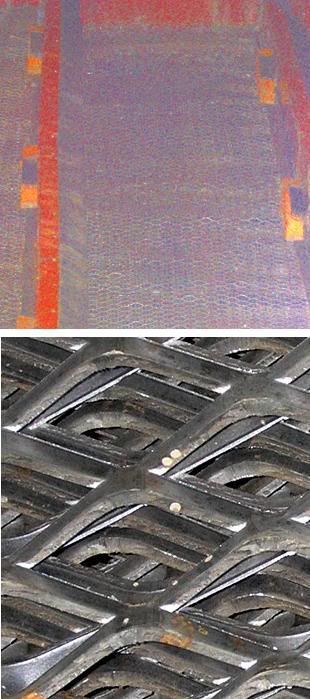
Steppe
Mongolia's fleet of five large Siberian bucket-line dredges were originally all equipped with inclined flat bar riffles set on square-ribbed black rubber matting.
Since then, several have been upgraded by installing new sluices consisting of large expanded metal MESH, still on square backed ribbed rubber matting. Unfortunately these are not as effective as they could be, being flexible MESH prone to buckle and warp up off the matting, rigid GRATING would have been better.
Here are some unique pictures of sluices of one of these giant dredges, minutes after the new riffles were installed:

Steppe
What should interest you guys and gals who know the Snowstorm Dredge well, is that the Siberian Dredges have self-cleaning sluice boxes. Think of 20-30 sluice boxes in a row (in parallel), all on wheels on a track, all on an endless chain. Every few minutes, CLANG!, and the whole lot moves to the left, sending the end sluice box off the end to turn upside down, while a freshly cleaned sluicebox appears at the other end. Its a bit hard to explain. Think of the 7 dwarves in bed, lets make it 40 dwarves and a bed with room enough only for 20. One fed up dwarf climbs in the bed and all the sleeping dwarves shuffle along and so Happy is shoved out of the other side of the bed. Happy ends up upside down under the bed, and has to wait his turn until every dwarf is shoved out of bed.
Anyway here are the wheels on a sluicebox:

Steppe
Anyway here are the wheels on a sluicebox:

Steppe
The Siberian bucket line dredges are good at digging and washing riverl alluvials. But two of the five also have gold-rich stiff red paleoplacer clay of Neogene age to content with - laterite clay. As a test I left a chunk in my apartment and it turned quickly into a solid brick!
The buckets of the bucket line dredges scoop up the clay with no problem. However, the huge on-board trommels cannot dissaggregate the clay fully. Some go down the sluices as goo-ey gold robbers, picking up gold as they go, and report to the fine (undersize) sluice tailings.
The bigger clay balls report to the rear stacker conveyor and hey they balls are rich in gold! Here is a local stealing a clay ball:
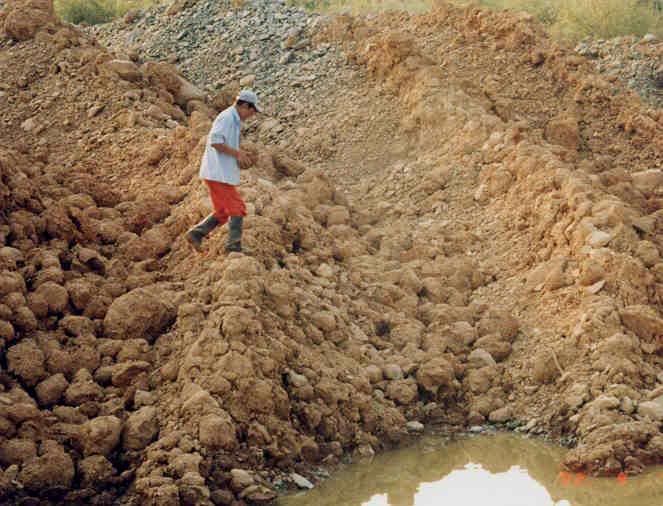
And here are 300 local 'informal' miners doing the same:

The clay balls are washed by hand in green bowls - this is bowling, a bit different from panning!
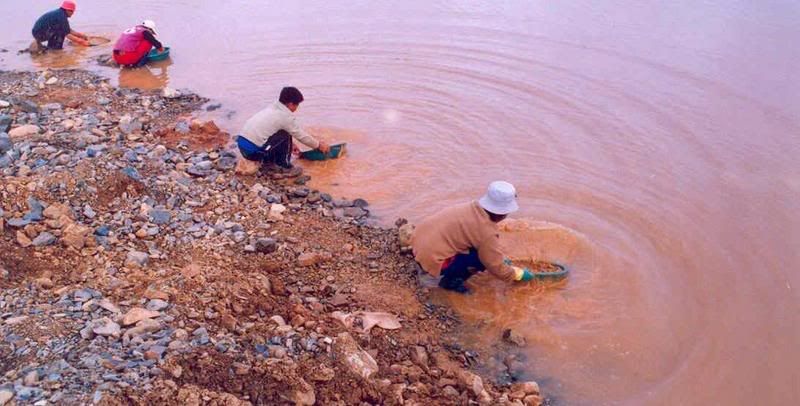
And here are the locals running away when the security guards arrived:

So, if you are looking at dredge tailings for gold, particularly nuggets, the place to look may be the bits of the dredge tailings that are mounded up (banana-shaped ribs on the back of the crocodile of tails) yet have revegetated faster than normal. That's due to clay balls being chucked out of the rear end of the dredge. No all clay balls have gold, but when they do then 300 people make a living!
Steppe
The buckets of the bucket line dredges scoop up the clay with no problem. However, the huge on-board trommels cannot dissaggregate the clay fully. Some go down the sluices as goo-ey gold robbers, picking up gold as they go, and report to the fine (undersize) sluice tailings.
The bigger clay balls report to the rear stacker conveyor and hey they balls are rich in gold! Here is a local stealing a clay ball:

And here are 300 local 'informal' miners doing the same:

The clay balls are washed by hand in green bowls - this is bowling, a bit different from panning!

And here are the locals running away when the security guards arrived:

So, if you are looking at dredge tailings for gold, particularly nuggets, the place to look may be the bits of the dredge tailings that are mounded up (banana-shaped ribs on the back of the crocodile of tails) yet have revegetated faster than normal. That's due to clay balls being chucked out of the rear end of the dredge. No all clay balls have gold, but when they do then 300 people make a living!
Steppe
I'd like some comparative facts.
1. What size of suction dredge woul it take to equal the cubic yards moved by a cutter dredge?
2. What is the cost of operation for a cutter dredge?
3. What would be the cost of operation for a suction dredge as mentioned in #1?
4. What is the overall recovery of the cutter drdge in a 24 hour period compared to the suction dredge in #! for the same 24 hour period?
5. What are the manpower requirements for both dredges?
6. What is the actual down-time of the cutter dredge in comparison to the expected down-time for the dredge in #1?
7. Are they hiring?
1. What size of suction dredge woul it take to equal the cubic yards moved by a cutter dredge?
2. What is the cost of operation for a cutter dredge?
3. What would be the cost of operation for a suction dredge as mentioned in #1?
4. What is the overall recovery of the cutter drdge in a 24 hour period compared to the suction dredge in #! for the same 24 hour period?
5. What are the manpower requirements for both dredges?
6. What is the actual down-time of the cutter dredge in comparison to the expected down-time for the dredge in #1?
7. Are they hiring?
Hey Steppe,
Had an idea as I was reading through the last post the other day ....chuckling at the flee of bowlers.....
When the thought occured to me that maybe that is an opportunity for the company that is being missed!
What if the dredge company actually set up to hire these locals.......who obviously are in need of something to do. Now maybe hire isn't quite the right word.....maybe contract labor would be more accurate.
Set up a "bowling" area and give em' each a cut or % to process those nasty ol' gold robbin clay balls for the company!
Course' the security gaurds will need a replacement activity to make up for the loss of excersise!

Just a thought......ifin it works out for the company you can send me a cut for consultations!!


Thanks for the pics
CP
Had an idea as I was reading through the last post the other day ....chuckling at the flee of bowlers.....
When the thought occured to me that maybe that is an opportunity for the company that is being missed!
What if the dredge company actually set up to hire these locals.......who obviously are in need of something to do. Now maybe hire isn't quite the right word.....maybe contract labor would be more accurate.
Set up a "bowling" area and give em' each a cut or % to process those nasty ol' gold robbin clay balls for the company!
Course' the security gaurds will need a replacement activity to make up for the loss of excersise!
Just a thought......ifin it works out for the company you can send me a cut for consultations!!
Thanks for the pics
CP
Been away for awhile this is a great thread cant wait to see and read more ..
Jeff
Jeff
This is not an old picture in the USA it is of one of the 6 giant gold dredges in Mongolia.
Its what we call the 'North Dredge' of Shijir Alt company, strictly speaking its Shijir Alt #1.

Thanks to Golden Tiger Corporation for the picture.
Its a bucket-line dredge built in Irkutz in Siberia by IZTM who built all 6 of the Mongolian Dredge Fleet and also built the entire Russian Dredge Fleet and they include not only gold dredges but also a few platinum and diamond dredges.
Its what we call the 'North Dredge' of Shijir Alt company, strictly speaking its Shijir Alt #1.

Thanks to Golden Tiger Corporation for the picture.
Its a bucket-line dredge built in Irkutz in Siberia by IZTM who built all 6 of the Mongolian Dredge Fleet and also built the entire Russian Dredge Fleet and they include not only gold dredges but also a few platinum and diamond dredges.
Just wondering, would it be possible to visit those dredges?
Anything new to these dredges?
Tony Beets got one going again. History being brought back and made. 

And I'd better show you some buckets on a line to show these really are bucket-line dredges and so do their own digging and feeding unlike the dragline-fed Snowstorm Dredge (as I understand it?).
Here are the buckets of the Bayangol Dredge.

Here are the buckets of the Bayangol Dredge.

I may not understand the whole concept, but I pray to God I never see one of these in Colorado. I would have to protest.
Hi Silky,
Not sure why you'd want to protest this type of machine in Colorado, it's actually a good way to extract placer gold from the alluvial deposits without chemicals. They only use water when working and the material thrown out (gravels) are in fact a viable commodity to sell for other uses such as road building (pavement making) as well as concrete mixes or river bed stones for non water/zero landscaping. A ready to use washed product as a by product of the operation, that includes all the sand and gravels.
I'd love to see one start up again in Colorado and hope they'd have jobs open, I'd like to try working on one!! Tony Beets may be a little hard to work for though!

Not sure why you'd want to protest this type of machine in Colorado, it's actually a good way to extract placer gold from the alluvial deposits without chemicals. They only use water when working and the material thrown out (gravels) are in fact a viable commodity to sell for other uses such as road building (pavement making) as well as concrete mixes or river bed stones for non water/zero landscaping. A ready to use washed product as a by product of the operation, that includes all the sand and gravels.
I'd love to see one start up again in Colorado and hope they'd have jobs open, I'd like to try working on one!! Tony Beets may be a little hard to work for though!
This is a "lo-fi" version of our main content. To view the full version with more information, formatting and images, please click here.
